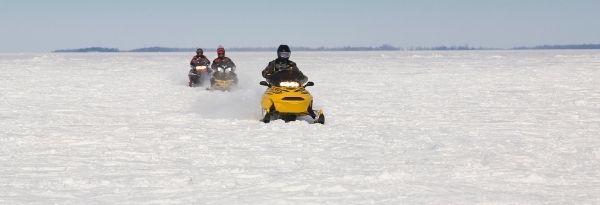2022-Jan-28
No Ice is Safe Ice! If Venturing Out, Here's What You Need to Know

According to the Insurance Bureau of Canada between 25 and 30 Canadians die in ice-related incidents each year and many more have to be rescued. As the weather gets colder, it is enticing to want to venture out onto the ice. It is important to remember that the most dangerous time to be on the ice is in early winter and late spring when the ice can be less stable.
Even if the ice is thick enough to venture out on, there are still risks. The quality and thickness of ice can change quickly and can vary from location to location.
If you are going out on the ice:
- always let someone know where you are going and when you expect to return
- know the waters under the ice you will be on – depth and currents can impact the thickness and strength
- watch the weather, as temperature fluctuations and precipitation may soften the ice
- avoid slushy ice, untracked ice or ice near moving waters or dock bubblers

The following is a list of 10 Ice Safety tips published by the Insurance Bureau of Canada:
10 Ways to Avoid Ice Hazards
- Use designated ice surfaces
- Many communities have designated ponds or outdoor ice surfaces, for activities such as skating, that are maintained by knowledgeable personnel. Designated ice should be regularly tested to ensure that it is thick enough and strong enough for recreational use.
- Measure ice thickness in several locations
- Local conditions such as currents and water depths can affect ice thickness. White ice has air or snow within it and should be considered suspect for recreational use.
- Avoid travelling on ice at night or when it is snowing
- Reduced visibility increases your chances of walking or driving onto an open or weak ice area. This is a frequent cause of ATV and snowmobile-related drowning.
- Never go onto ice alone
- A companion may be able to rescue you or go for help if you get into difficulty. Before you leave shore, tell someone where you are going and what time you expect to return.
- Stay off river ice and avoid the narrows between lakes
- River currents and moving water at the narrows where one lake flows into another can quickly change ice thickness or cause ice to be much thinner than in other locations on the river or on the lake.
- Wear a thermal protection buoyant suit or a lifejacket
- If you don’t have a thermal protection buoyant suit, wear a lifejacket or PFD over your snowmobile suit or layered winter clothing to increase your survival chances if you go through the ice.
- Take safety equipment with you
- Pack ice picks, a rope and a small personal safety kit (a pocket knife, compass, whistle, fire starter kit and cellphone) in your pockets or backpack.
- Avoid alcohol
- Alcohol impairs your judgment, coordination and reaction time and speeds up the onset of hypothermia.
- Don’t drive on ice if you can avoid it. If you can’t avoid it, have an escape plan
- Open your windows, unlock your doors and turn on available lights to allow for a quick escape from your vehicle. Some ice safety experts recommend that you have your seatbelt unfastened and your door slightly ajar to speed up an escape. Don’t wear a lifejacket while riding inside an enclosed vehicle; the extra bulk and flotation could hamper your escape through a window.
- Always supervise children playing on or near ice
- Children playing on or near ice should always be with a companion and under adult supervision.
 Snowmobiling
Snowmobiling
Adhering to land-based Ontario Federation of Snowmobile Clubs (OFSC) prescribed trails whenever possible offers the safest snowmobile terrain. Interactive trail maps can be found here. If you must travel on ice surfaces, it is strongly recommended that you wear proper survival clothing; take a fully charged cell phone with you; and tell a friend, neighbour or family member of your destination.
The OPP want everyone venturing out onto the ice to please check in with area residents, anglers, fish hut operators and area marinas as “we are all in this together” if you go through the ice. Emergency services will respond once they are advised but the effects of ice cold water on your body mean that “self rescue” is likely your best and possibly your only chance to get out of the water.
Need more information on how to survive an accidental cold water immersion? Canadian Safe Boating Council is hosting virtual Cold Water Awareness workshops featuring Dr. Gordon Giesbrecht (aka Professor Popsicle), an expert in hypothermia. Get all the details here.
Additional Articles and Resources:
